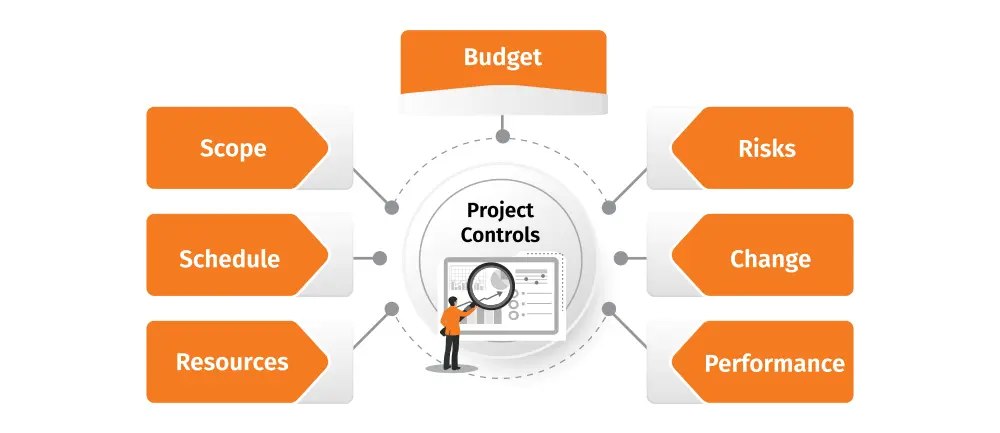
The difference between project success and failure often comes down to one critical discipline: project controls.
In this guide, we will define project controls, explore its essential role in ensuring successful outcomes, and highlight how it prevents project failure. You’ll also learn about its key elements and when to engage it throughout the project lifecycle, including how project controls software can enhance performance and decision-making.
What is project controls?
Project controls correspond to structured processes used to measure, track, forecast, and manage a project’s performance to ensure it stays within schedule and budget constraints. These procedures involve gathering and analyzing data to measure progress, identify trends, anticipate deviations and potential issues, and implement corrective actions throughout the project lifecycle to keep the project aligned with its objectives.
Project controls involve:
- Establishing and maintaining baseline plans for schedule, cost, and scope
- Collecting and analyzing performance data against these baselines
- Identifying variances and potential risks
- Forecasting future performance based on current trends
- Implementing corrective actions to address deviations
- Reporting project status to stakeholders
Overall, these processes support every stage of the project lifecycle, from initiation and planning to execution, monitoring, and closeout, by focusing on cost, schedule control, risk mitigation, and the effective use of allocated resources. By creating visibility into project performance through data-driven insights, teams can then make informed decisions before problems escalate, reduce uncertainty, and improve project outcomes.
Common activities in this discipline include:
- Creating S-curves and earned value charts to visualize performance trends
- Implementing variance thresholds and escalation protocols
- Conducting quantitative risk analysis and contingency planning
- Producing stakeholder-specific dashboards and KPI reports
Elements of project controls

Scope management
Scope defines what is and isn’t part of the project. Thus, controlling scope involves clearly outlining deliverables, setting boundaries, and managing scope creep through structured change processes. It ensures the project team is aligned on expectations and helps avoid miscommunication and over-extension.
Schedule control
Time is one of the most visible project constraints. Schedule control involves building and maintaining realistic timelines by continuously monitoring the critical path, milestone tracking, and CPI analysis. By closely monitoring timelines, teams can identify deviations early and reallocate resources or adjust plans before delays escalate.
Resource management
The right workforce, tools, and materials must be available at the right time and place throughout the project lifecycle. This involves planning resource allocation, tracking usage, and resolving conflicts that could affect delivery. Effective resource control is key to avoiding bottlenecks, maintaining productivity, and preventing budget and schedule overruns. This element is partly related to schedule control.
Risk management
Projects are always exposed to both known and unforeseen risks. Effective project risk management requires a structured approach to identifying, assessing, and addressing these risks before they can impact scope, schedule, or budget. Keeping a live risk register, assessing probability and impact, and preparing mitigation or contingency budgets can help teams mitigate potential risks and, in some cases, avoid them altogether.
Change management
No project ever runs exactly as planned; some degree of change is inevitable. Change control provides a structured approach to evaluate, approve, and manage modifications to the project’s scope, schedule, or budget. A strong change control process not only prevents scope creep and ad hoc decisions from derailing the project but also ensures changes are understood, documented, and aligned with stakeholder expectations. By tracking the impact of changes and maintaining accountability, teams can adapt with control rather than chaos.
Budget management
Keeping the project under budget requires continuous tracking, forecasting, and financial accountability. By monitoring actual vs. planned spend, refining time-phased budgets, and managing contingencies, teams can gain clear visibility into cost performance. A well-maintained budget serves as a benchmark throughout the project, helping both project teams and stakeholders understand where and why variances occur so that corrective actions can be taken proactively.
Performance management
Performance management integrates key factors like cost, schedule, and scope to keep projects on track. By using dashboards and monitoring key performance indicators (KPIs) such as cost performance index (CPI), schedule performance index (SPI), or even critical path length index (CPLI), cost variance, schedule variance, and resource utilization, teams can gain real-time insights into project health. This enables early identification of deviations, allowing teams to take timely corrective actions (e.g., reallocating resources, adjusting timelines) to stay aligned with strategic goals.
The importance of project controls: preventing project failure
Project controls isn’t a support function, it is a critical driver of project success. In fact, according to our industry survey, 90% of participants identified project controls as very important or extremely important to delivering successful outcomes.
Adequate project controls are essential to establish a realistic project timeline, estimate the project budget accurately, and keep the project on track. Without these processes in place, organizations are far more likely to face cost overruns, schedule delays, and poor visibility, leaving the project management team unable to make informed decisions. Without the right information at hand at the right time, issues can escalate quickly and derail even the best-planned projects.
Project size matters
The value of this discipline seems to become even more pronounced as project size increases, with the same survey finding that organizations managing large-scale projects are 1.7 times more likely to consider project controls extremely important compared to those handling smaller initiatives. This correlation makes sense given that larger projects often involve more stakeholders, complex interdependencies, greater financial stakes, and extended timelines that increase exposure to potential risks. All these factors amplify the need for tighter project oversight. Although typically, you see that overruns in smaller projects are often bigger when looking at it from a percentage deviation perspective.
Project complexity matters
That said, size doesn’t always equal complexity. A large-scale project may follow a familiar, well-defined process, while a smaller initiative could be highly complex. For instance, it could involve new technologies, regulatory challenges, or significant cross-functional collaboration. These types of projects often require more rigorous tracking, more frequent updates, and highly structured communication plans to manage expectations. In some cases, status reporting may need to happen multiple times a week or even daily.
The way these processes are applied may vary, but their presence is essential across all projects to ensure predictable and informed data-driven decisions.
When to engage project controls
![]()
Successful projects don’t wait until things go off track to implement project controls. Instead, they apply it through the entire project lifecycle.
According to the industry survey, 84% of organizations reported using project controls during the execution phase. But interestingly, those that engaged these processes as early as the feasibility phase were almost 10% more schedule successful.
That tells us something important: project controls add value at every stage, not just once execution begins.
Here’s how that usually looks across the project lifecycle:
Project feasibility & concept
Even at this early stage, it is worth applying project controls. Think of early cost modeling, high-level schedule projections, and risk assessments. Basic forecasting and scenario planning at this point can also help test whether a project is viable before investing significant time or budget.
Project planning & definition
At this stage, teams define the project’s baseline for cost, schedule, scope, and define how performance will be tracked. Key activities can include building a work breakdown structure (WBS), assigning roles and responsibilities, mapping out a realistic timeline, and identifying risks and stakeholders. A detailed budget is also developed, often with cost estimates tied to scope and resource needs. Getting this right upfront will reduce surprises during execution.
Project execution & start-up
In this stage, monitoring performance, comparing progress against baselines, identifying variances, and making data-driven decisions to stay on track are crucial. Tools like earned value management (EVM), forecasting, and change control procedures come into play here.
Project close-out
Including a post-project review, often referred to as lessons learned or a close-out report, will enable teams to feed valuable information into future initiatives and ensure continuous improvement.
Project controls software tools can make all the difference

Relying on manual methods to manage cost, schedule, and risk is no longer enough. As projects grow in complexity and scale, effective project controls demand advanced tools that go beyond spreadsheets and static reports.
Tools like Cleopatra’s project controls software solution enhance communication, streamline processes, automate reporting, and integrate data across systems to provide real-time insights. Dedicated software systems distribute workloads more effectively, saving valuable time and increasing resilience to changes. Ultimately, selecting the right software not only optimizes project controls but also empowers teams to boost performance and deliver better results.
Effective project planning lays the groundwork for success yet challenges often arise beyond the initial blueprint. Among these…
Managing a project and keeping it under “control” can be an extremely challenging process. That’s where project controls…
FAQs
-
What is the difference between project controls and project management?
Project controls is a subset of project management. While project controls is concerned with keeping the project on schedule and within budget, project management oversees the entire project lifecycle, also incorporating quality, communication, and team coordination.
While a project controller monitors project health to highlight risks and suggest recovery strategies to limit delays and cost overruns, the project manager uses that input to make strategic decisions and lead the project forward.
Related resources

What is Project Cost Management? Steps, Benefits, and Tips
This article explains the different steps and processes in Project Cost Management, following methods like AACE International's TCM Framework.
Read blog article
An Earned Value Management (EVM) Guide
Scope creep, budget constraints, and aligning actual work with planned tasks are just a few of the challenges faced by project managers. Ever wondered how amid these obstacles project managers keep track of progress effectively? Earned Value Management (EVM) is their not-so-secret weapon. Understanding EVM's significance is crucial; it not…
Read blog article